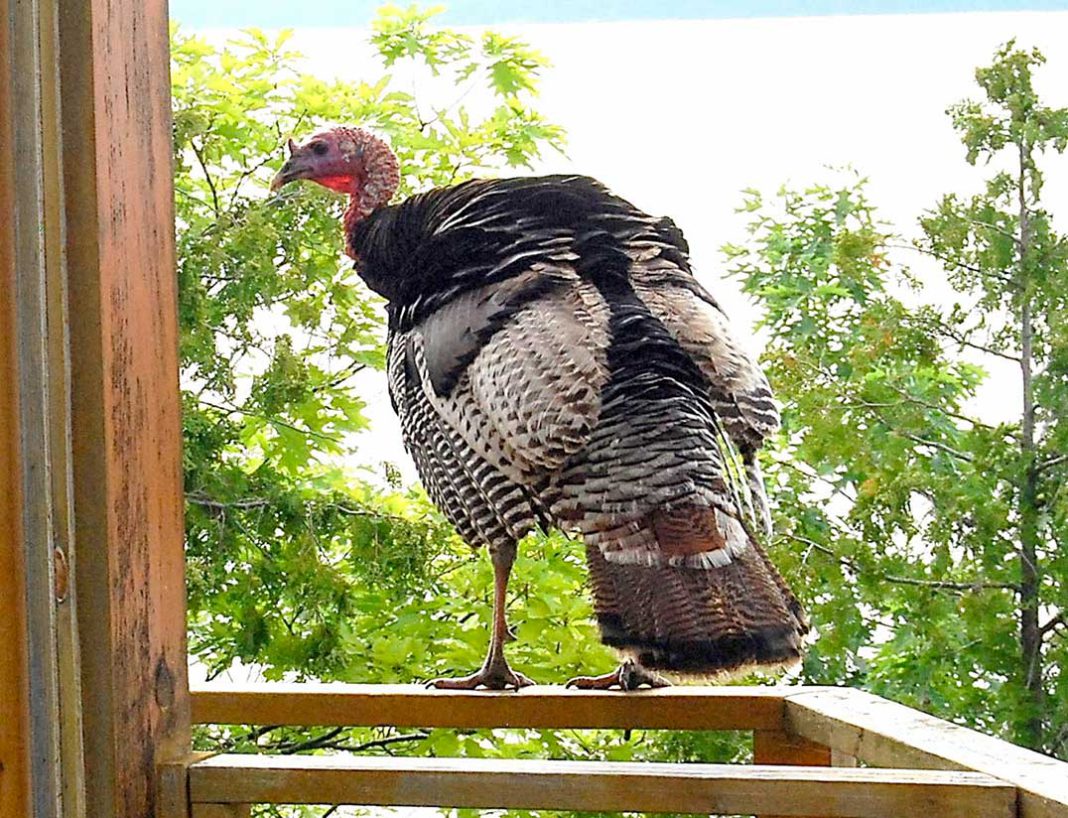by Joe D. Shorthouse
LAKE MINDEMOYA—During a recent stay at the Rock Garden Terrace Resort on the west side of Lake Mindemoya, my wife and I were told upon arrival for a celebration of our wedding anniversary, that a family of wild turkeys was on the property. Wild turkeys are not common on Manitoulin Island, so I secretly hoped that our anniversary would include a chance to observe and photograph these amazing birds.
Sure enough, just as the sun was rising the next morning, I heard the distinctive call of a male (called toms or gobblers) and it sounded nearby. Having the choice of waking up with my bride of 45 years on the day of our anniversary, or chasing a wild turkey, I grabbed my camera and quietly slipped out of the room.
As luck would have it, a large tom turkey was walking around one of the pools of the spa, which are near the restaurant of the motel. When I approached, he hopped onto an adjoining railing and seemed content to sit there while I slowly approached snapping pictures with each step as I expected it to run or fly away at any moment.
Once I got within eight metres, he walked along the rail that ran behind one of the spa buildings. I ran into the building and was able to approach within one metre as the bird was on the other side of a screened window. We eyed each other for about a minute and up close it was obvious how birds and dinosaurs had common ancestors. He then flew into a nearby tree.
Back outside, I was able to stand by the railing and stare across at the bird which was now perched in a tree that was growing at the base of the cliff. The resort is at the top of a limestone cliff which meant that I had the rare opportunity of observing and photographing a wild turkey that was at eye level even though it was near the top of a tall tree.
While on the railing and in the tree, the tom filled the air with its loud exuberant gobbling, likely the means by which it was trying to communicate with and locate its flock.
Wild turkeys are large, plump birds with long legs. They have wide, rounded tails, and a small head on a long, slim neck. They are dark overall with a bronze-green iridescence to most of their plumage.
The heads and throats of toms are feather free and usually reddish. They also have red wattles on the throat and neck. Fleshy growths called caruncles arise from the head. Males also have a “beard,” a tuft of coarse hair (modified feathers) growing from the center of their breast.
Turkeys get around mostly by walking, but they run quickly or fly when threatened. Males tend to run when threatened and can reach 40 km per hour, whereas females usually fly. Females can fly at speeds of 80 km per hour. At sundown turkeys fly onto limbs of trees where they spend the night in flocks.
Turkeys travel in flocks and feed mostly on plant matter. They scratch the ground with their strong feet to search for nuts, seeds, berries, and insects. Like most birds, they swallow grit to help digest their food.
Wild turkeys are native to North America and is the same species as the domestic turkey which was originally derived from a Mexican subspecies. Spanish explorers brought some of these turkeys home from Mexico in the early 1500s.
It is thought that turkeys got their name from the domesticated variety being imported to Britain. The British thought the birds came from the Middle East and the country Turkey and the name stuck. English colonists settling on the east coast brought domesticated turkeys with them.
Wild turkeys were once common throughout southern Ontario, but were hunted to extinction over 100 years ago. The Ontario government started a reintroduction program in 1984 and good populations are now found in many parts of southern Ontario.
There are reports of birds being found as far north as Sudbury and Sault Ste. Marie. It is thought that residents of Manitoulin introduced wild turkeys to Manitoulin Island and according to local ornithologists, there are about 10 healthy flocks.
EDITOR’S NOTE: Joe Shorthouse is professor emeritus of biology at Laurentian University and enjoys writing, photographing and talking about the natural world on Manitoulin Island and the hills of Sudbury.





